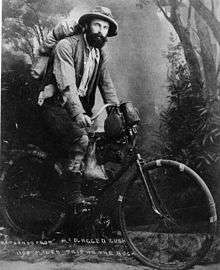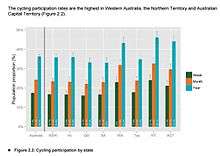Cycling in Australia
Cycling in Australia is a common form of transport, recreation and sport.
Many Australians enjoy cycling because it improves their health and reduces road congestion and air pollution. The government has encouraged more people to start, with several state advertising campaigns aimed at increasing safety for those who choose to ride. There is a common perception that riding is a dangerous activity. While it is safer to walk, cycling is a safer method of transport than driving.[1] Cycling is less popular in Australia than in Europe, however cyclists make up one in forty road deaths and one in seven serious injuries.[2]
In 2012, for the thirteenth year running, bicycle sales in Australia have outpaced car sales.[3]
History

Bicycles arrived in Australia in 1860s, and it was quickly adopted with touring and racing clubs forming.[4]
By the 1890s cycling was accessible to the middle class, and long distance cycle travelling was a fact of life for many sheep shearers and other agricultural labourers with migratory work.[5] The bicycle and swag conquered much of Australia on dusty dirt tracks, long before the automobile made its appearance. In the main, however, long distance cycling was a sport of endurance or was done out of necessity.
At the same time, racing became quite popular with the Austral Wheel Race beginning in 1887, and leading to the development of the Malvern Star cycling brand.[6]
Between 1990 and 1992 Australia become the first country to make wearing helmets compulsory, after a number of studies indicated that they reduced head injuries.[7] After their introduction, the overall number of riders decreased, mostly due to a decline in children riding to school. This has not conclusively shown to be due to mandatory helmet laws and may have followed pre-existing trends dating from the 1970s.[8][9][10]
Laws

Cyclists in every state are required to follow normal road rules, including using traffic lights correctly and observing give way and stop signs while riding on the road.
Cyclists in every state must wear helmets while in motion. All cyclists must only use the left hand lane, except in Queensland. All states require only one passenger per bicycle unless the bicycle is designed otherwise.
Bike users in Western Australia and Tasmania must use both hand signals, while in Victoria, Queensland and Northern Territory cyclists must signal when turning right but it's not compulsory when turning left.
Cyclist must have at least one hand on handle bars in Western Australia, Northern Territory and Queensland.
Cyclist may ride on standard footpaths in Western Australia, Northern Territory, South Australia and Australian Capital Territory. In Victoria cyclists can only ride on a footpath if they're under the age of 12 or supervising a child under 12, or have a disability which restrains them from being able to ride on the road. In New South Wales cyclists can only ride on a footpath if they're under the age of 16 or supervising a child under 16. In Queensland cyclists can ride on any path as long as there isn't a sign stating otherwise.
Cyclists may ride in groups or bunches in all Australia States and territories, riding two abreast riders must be no more than 1.5 meters apart.[12]
Cyclists across Australia must follow the same rules as motor vehicle drivers in regards to using mobile phones and consuming alcohol.
Cyclist also need to use a bike light when riding at night in Western Australia, Tasmania, Northern Territory, South Australia and Queensland.[13][14][15][16][17][18][19]
Types of cycling
Recreational cycling
Many Australians ride a bike for recreation or commuting.
In 2017 1.4% of commuters cycled to work of which 75% were male. Most are concentrated in the flatter parts of major cities, close to the CBD.[20]
In 2017 15.5% of Australians ride a bike at least weekly, declining from 18.2% in 2011.[21]
The National Cycling Strategy was tasked with doubling the number of people cycling from 2011 to 2016, which was not achieved. Demographic changes, and decreasing numbers of riders within capital cities accounted for most of the decrease.[21] Some of the decrease within NSW has been blamed on increased cycling fines implemented in 2016.[22]
The NCS has found that cycling was the most common in Western Australia, the Northern Territory and Australian Capital Territory during 2015. Victoria and Queensland have decreased in participation between 2011 and 2015.[21]
Doubling the number of bike users has the potential to increase the safety for all riders by helping to make drivers more aware of bicycles on the road, and adding pressure to those who already cycle to obey the road rules. More bike users also has an economic benefit which is estimated in Australia to be $1.43 per kilometre for every person cycled.
There are a number of trails and shared paths in the major cities.[11]
Cycling as a sport
Australia hosts the Tour Down Under which is the only UCI World Tour event in the southern hemisphere. Australians place strongly in cycling at the Olympic Games, UCI World Championships and other international events.
Australia has hosted the UCI Road World Championships, UCI Track Cycling World Championships and UCI Mountain Bike & Trials World Championships. Most state capitals have an indoor velodrome.
Cycling organisations
National bodies
- Audax Australia, long distance road cycling
- Bicycle Network is Australia's largest cycling membership organisations (45,000 members, 2015)[23] with offices in Victoria and Tasmania.[24]
- Cycling Australia[25] - the national administrative body responsible for the sport of cycling in Australia[26]
- Cycling Promotion Fund [27]
State bodies
Magazines
Websites
- CycleLifeHQ - a website for finding the best bike rides in Australia
Awards
The Australian Bicycling Achievement Awards, an initiative of the Cycling Promotion Fund, have been held annually since 2002.[36]
See also
- Bicycle helmets in Australia
- Ciombola, a bike frame company active between 1998 and 2005
- Cycling in New South Wales
- Cycling in Sydney
- Cycling in Victoria
- Mountain biking in Australia
References
- Arnold, Tony (December 2014). "Cycling safety in Australia". Journal of the Australasian College of Road Safety. Retrieved 17 May 2016.
- Garrard, J (August 2010). "Cycling injuries in Australia: Road safety's blind spot?". Journal of the Australasian College of Road Safety. Retrieved 17 May 2016.
- Standing Council on Transport and Infrastructure (15 November 2013), Standing Council on Transport and Infrastructure Communiqué (PDF), p. 4, archived from the original (PDF) on 27 November 2013
- corporateName=National Museum of Australia; address=Lawson Crescent, Acton Peninsula. "National Museum of Australia - History". www.nma.gov.au.
- "On your bike: The history of cycling in Sydney - PHA NSW & ACT".
- "History of cycling in Australia". Australian Geographic. 24 May 2016.
- Curnow, W. J. "Bicycle Helmets: A Scientific Evaluation" in Anton De Smet (2008). Transportation Accident Analysis and Prevention (PDF). Commack, N.Y: Nova Science Publishers. ISBN 978-1-60456-288-0.
- Garrard, Jan. "Why aren't more kids cycling to school?". The Conversation.
- http://unsworks.unsw.edu.au/fapi/datastream/unsworks:50591/bina856ed10-ec7b-48ad-aac8-a69c35d75384?view=true
- Robinson, D. L. (2006). "No clear evidence from countries that have enforced the wearing of helmets". BMJ. 332 (7543): 722.2–725. doi:10.1136/bmj.332.7543.722-a. PMC 1410838. PMID 16565131.
- Munro, Cameron (July 2015). "National Cycling Participation Survey 2015". Australian Bicycle Council.
- http://classic.austlii.edu.au/au/legis/act/consol_reg/rtrr2017382/s151.html
- "Cycling in WA". Cycling in WA. Government of Western Australia. 5 November 2015. Archived from the original on 8 April 2016. Retrieved 17 May 2016.
- "Centre for Road Safety". Staying Safe. Transport for NSW. 21 December 2015. Retrieved 17 May 2016.
- "Road Safety Advisory Council". Bike riders. The Department of State Growth. 20 October 2015. Archived from the original on 4 June 2016. Retrieved 17 May 2016.
- "Cyclist road rules and safety". Cyclist road rules and safety. The Government of South Australia. 2016. Archived from the original on 11 June 2016. Retrieved 17 May 2016.
- "Territory and Municipal Services". Road Rules. ACT Government. 17 March 2016. Retrieved 17 May 2016.
- "BicycleNT". NT road rules. BicycleNT. Archived from the original on 9 May 2016. Retrieved 17 May 2016.
- "Victoria Law Foundation". Bike Law. Monkii. 11 March 2016. Archived from the original on 6 May 2016. Retrieved 17 May 2016.
- "Subscribe to The Australian | Newspaper home delivery, website, iPad, iPhone & Android apps". myaccount.news.com.au.
- "National Cycling Participation Survey 2017" (PDF). National Cycling Strategy 2011-2016.
- "In response to a year of increased cycling fines | Bicycle NSW".
- "Bicycle Network". Bicycle Network. 2016.
- Bicycle Network (2016). "Bicycle Network". Bicycle Network.
- Cycling Australia, Cycling Australia, Cycling Australia, archived from the original on 28 October 2013, retrieved 27 November 2013
- Cycling Australia, About Cycling Australia, Cycling Australia, archived from the original on 27 November 2013
- Cycling Promotion Fund, CPF News, Cycling Promotion Fund, retrieved 27 November 2013
- "West Cycle - our history". NCLS Research. West Cycle. 28 February 2012. Archived from the original on 20 February 2016. Retrieved 20 January 2016.
- Amy Gillett Foundation, Amy Gillett Foundation: Safe together, Amy Gillett Foundation, retrieved 27 November 2013
- Amy Gillett Foundation, About AGF, Amy Gillett Foundation, archived from the original on 2 May 2013
- Cyclist Magazine, Cyclist Magazine, Citrus Media, retrieved 20 November 2019
- Treadlie Magazine, Treadlie magazine, Green Press P/L, retrieved 27 November 2013
- Treadlie Magazine, About Us, Green Press P/L, archived from the original on 27 November 2013
- Bicycling Australia Magazine, Bicycling Australia, Lake Wangary Publishing Co, retrieved 27 November 2013
- Bicycling Australia Magazine, Welcome to Bicycling Australia, Lake Wangary Publishing Co, archived from the original on 23 August 2013
- Australian Bicycling Achievement Awards, Australian Bicycling Achievement Awards booklets, Cycling Promotion Fund, archived from the original on 27 July 2013
References and further reading
| Wikimedia Commons has media related to Cycling in Australia. |
- Cycling Promotion Fund, Bicycle Sales 2009 (PDF), Cycling Promotion Fund, archived from the original (PDF) on 23 September 2015, retrieved 27 November 2013
- NSW Government, Bicycle Information for New South Wales, NSW Government, archived from the original on 21 November 2013, retrieved 27 November 2013